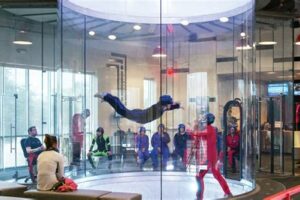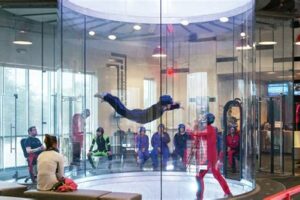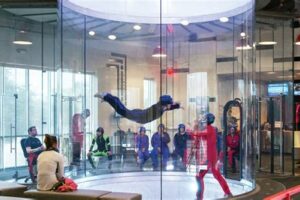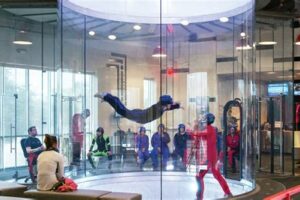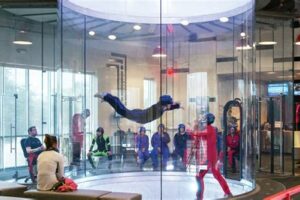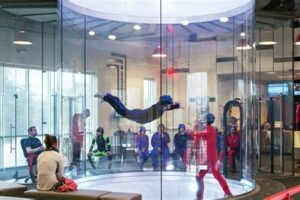Table of Contents
Discover the optimal temperature for skydiving and ensure a thrilling experience in the skies. Find out the ideal climate conditions that provide the best safety and comfort for this adrenaline-pumping adventure. Prepare yourself for an unforgettable jump by understanding the importance of temperature in skydiving.
Skydiving is an exhilarating adventure that offers a thrilling experience like no other. However, the success and safety of this adrenaline-pumping activity heavily rely on various factors, one of which is the temperature. The ideal temperature for skydiving can significantly impact the overall enjoyment and comfort of the jump. Whether you are a seasoned skydiver or a first-timer, understanding the best temperature for skydiving is crucial to ensure a memorable and safe experience. So, let’s delve into the realm of skydiving temperatures and explore why it matters so much.
The Importance of Temperature in Skydiving
Skydiving is an exhilarating sport that involves jumping from an aircraft and free-falling before deploying a parachute for landing. The success and safety of a skydive are influenced by various factors, including weather conditions. Among these weather considerations, temperature plays a crucial role in ensuring an enjoyable and secure skydiving experience. In this article, we will explore the best temperature for skydiving and how it affects both the equipment and the skydiver.
Optimal Temperature Range for Skydiving
While skydiving can be done in various weather conditions, a moderate temperature range is considered ideal for the most enjoyable and comfortable experience. The optimal temperature for skydiving typically falls between 60°F (15°C) and 80°F (27°C). This range provides a balance between comfort for the skydiver and the functionality of the equipment.
The Impact of Cold Temperatures
Extreme cold temperatures can significantly affect both the skydiver and the equipment. When the temperature drops below freezing, the skydiver’s body can lose heat rapidly, leading to discomfort and potential health risks. Additionally, cold temperatures can cause the equipment, such as the parachute and rigging, to become stiff and less responsive, increasing the chances of malfunction during deployment.
The Effects of Hot Temperatures
Similarly, excessively hot temperatures can pose challenges for skydivers. High heat can cause discomfort and dehydration, which can impair decision-making abilities and physical performance. Moreover, the intense heat can affect the functionality of the equipment, especially if it involves sensitive components. It is essential to avoid extreme heat to ensure a safe and enjoyable skydiving experience.
Wind Chill Factor
When considering temperature for skydiving, it is crucial to account for the wind chill factor. As you descend rapidly through the air during freefall, the wind can significantly impact the perceived temperature. The wind chill factor refers to how the combination of air temperature and wind speed makes it feel colder than the actual temperature. Therefore, even if the temperature on the ground seems within the optimal range, the wind chill factor at higher altitudes may make it feel colder.
Safety Considerations
While the optimal temperature range for skydiving is between 60°F (15°C) and 80°F (27°C), safety considerations should always take precedence. If other weather conditions, such as strong winds, heavy precipitation, or thunderstorms, are present, it is advisable to postpone the skydive regardless of the temperature. Safety should always be the top priority in any skydiving adventure.
Dressing Appropriately for Skydiving
To ensure comfort and safety during a skydive, it is important to dress appropriately for the prevailing weather conditions. Layers of clothing are recommended, as they allow for adjustment based on the temperature at different altitudes. Wearing a windproof outer layer can also help combat the wind chill factor. It is best to consult with the skydiving center or experienced skydivers for specific clothing recommendations based on the current temperature.
Equipment Considerations
The equipment used in skydiving is designed to withstand a wide range of temperatures, but extreme conditions can still affect its performance. Skydiving centers and equipment manufacturers follow strict guidelines to ensure the gear’s reliability in various weather conditions. However, it is essential to inspect the equipment thoroughly before each jump and follow the manufacturer’s instructions regarding temperature limitations to ensure optimal functionality.
Consulting with Experienced Skydivers
If you are new to skydiving or unsure about the best temperature conditions for your jump, it is highly recommended to consult with experienced skydivers or instructors. They have extensive knowledge and experience in navigating weather conditions and can provide valuable insights and guidance to ensure a safe and enjoyable skydiving experience.
Conclusion
The best temperature for skydiving falls within the range of 60°F (15°C) to 80°F (27°C) to ensure comfort, safety, and optimal equipment performance. However, it is crucial to consider other weather factors and the wind chill factor when planning a skydive. Always prioritize safety and consult with experts to make informed decisions regarding temperature and weather conditions for an unforgettable skydiving adventure.
The Importance of Ideal Temperature
When it comes to an adrenaline-pumping activity like skydiving, the temperature becomes a crucial factor in ensuring both safety and enjoyment. The best temperature for skydiving should provide a balance between comfort and optimal parachute performance, allowing jumpers to fully embrace the excitement in the sky.
Mild and Moderate Temperatures for a Pleasant Jump
Skydiving enthusiasts often find that mild to moderate temperatures ranging from 60°F to 85°F (15°C to 29°C) provide the ideal conditions for an exhilarating experience. These temperatures offer a pleasant and comfortable environment both during the ascend in the aircraft and the freefall, making the whole adventure more enjoyable.
Avoiding Extreme Heat for Safety Purposes
While warm temperatures can be attractive to some, skydiving in scorching conditions can come with potential risks. Extreme heat above 85°F (29°C) can lead to fatigue and dehydration, impacting decision-making abilities and overall safety during the jump. It is recommended to plan skydiving activities during cooler parts of the day or opt for cooler seasons to mitigate heat-related hazards.
The Challenges of Cold Weather Skydiving
While colder temperatures may seem less favorable for skydiving, they can still provide a thrilling experience with the right precautions. Skydivers should be equipped with proper clothing layers to combat the chilly air at high altitudes. Temperatures below 60°F (15°C) may require additional safety considerations, such as checking for ice formation on the aircraft or ensuring proper gear functionality.
Wind Chill Factor: A Key Consideration
In addition to the ambient temperature, skydivers must also take into account the wind chill factor. As the wind speed increases during the freefall, it can significantly impact the perceived temperature. Wind chill can make the air feel colder than it actually is and affect the body’s ability to regulate heat. It is essential to factor in wind chill when determining the best temperature for the skydiving experience.
Local Climate Considerations
When choosing the perfect time and place for skydiving, it’s crucial to consider the local climate conditions in the area. Different regions can experience distinct temperature patterns, humidity levels, wind speeds, and weather changes, all of which can impact the skydiving experience. Understanding the local climate will help in selecting the optimal temperature for a safe and enjoyable jump.
Time of Year: Timing is Key
The time of year can have a significant influence on the temperature suitable for skydiving. Spring and autumn often offer moderate temperatures without extreme heat or cold. These seasons can provide the perfect balance between enjoyable conditions and safety. However, it is important to research the specific weather patterns of the intended skydiving location for accurate planning.
Consultation with Skydiving Professionals
To ensure a memorable and safe skydiving experience, seeking advice from experienced skydiving professionals is highly recommended. They possess the knowledge and expertise in analyzing weather conditions such as temperature, wind, and precipitation, thus advising on the best times and conditions for an exciting jump. Always consult the professionals for personalized recommendations tailored to your specific skydiving preferences.
When it comes to skydiving, choosing the best temperature is crucial to ensure a safe and enjoyable experience. As a professional in the skydiving industry, I firmly believe that certain temperature ranges provide ideal conditions for this thrilling activity. Here are a few points from my perspective on the best temperature for skydiving:
-
Temperate Weather: Skydiving is best enjoyed in temperate weather conditions, typically between 60°F (15°C) and 80°F (27°C). This temperature range allows for comfortable jumps without excessive heat or cold affecting the overall experience. The moderate temperatures ensure that skydivers can focus on the thrill of the jump rather than being distracted by extreme weather conditions.
-
Optimal Comfort: Skydiving requires wearing specialized gear, including jumpsuits, helmets, and harnesses. These gears may add extra insulation to the body, making it important to choose a temperature range that allows for optimal comfort during the jump. Mild temperatures ensure that skydivers neither feel too hot nor too cold, enabling them to fully enjoy the breathtaking views and adrenaline rush of freefall.
-
Avoiding Temperature Extremes: Extreme temperatures, whether hot or cold, can significantly impact the safety and enjoyment of a skydiving experience. When the temperatures are too high, excessive heat can cause discomfort, dehydration, and fatigue, making it challenging for skydivers to fully concentrate on their jumps. On the other hand, extremely cold temperatures can lead to frostbite, reduced dexterity, and potential equipment malfunctions. Therefore, it is essential to avoid temperature extremes to ensure a safe and enjoyable skydiving adventure.
-
Stable Atmospheric Conditions: In addition to temperature, stable atmospheric conditions also play a vital role in skydiving. Ideally, skydivers aim for calm winds, clear skies, and minimal cloud cover. These conditions not only provide excellent visibility but also ensure predictable parachute deployments and landing patterns. While temperature alone does not guarantee stable atmospheric conditions, it is often observed that mild temperatures are associated with more favorable weather patterns for skydiving.
-
Consideration of Personal Preferences: Finally, it is important to consider individual preferences when determining the best temperature for skydiving. Some individuals may have different comfort levels or specific needs based on their physical condition or experience level. It is always recommended to consult with experienced skydiving professionals who can guide participants in choosing the most suitable temperature range based on their unique requirements.
In conclusion, the best temperature for skydiving typically falls within the range of 60°F (15°C) to 80°F (27°C), providing temperate weather and optimal comfort for jumpers. Avoiding temperature extremes is crucial to ensure safety and enjoyment during the experience. Additionally, stable atmospheric conditions, along with personal preferences, should be taken into account to create the perfect skydiving adventure. So, whether you are a seasoned skydiver or a first-time jumper, selecting the right temperature will undoubtedly enhance your skydiving experience.
Thank you for taking the time to visit our blog and learn more about the best temperature for skydiving. We hope that you found the information provided useful and informative. As professionals in the field, we understand the importance of choosing the right conditions for a safe and enjoyable skydiving experience. In this closing message, we would like to summarize the key points discussed in the article and offer some final thoughts.
Firstly, it is crucial to note that the ideal temperature for skydiving can vary depending on factors such as personal preference, location, and the type of jump you are undertaking. However, in general, a temperature range between 60°F (15°C) and 80°F (27°C) tends to be most comfortable for skydivers. This range provides a balance between the need for adequate warmth during freefall and the avoidance of excessive heat at lower altitudes. Transitioning from the aircraft to the sky and back to the ground can be a thrilling experience, and the right temperature ensures that you can fully enjoy the adrenaline rush without discomfort.
Secondly, when considering the best temperature for skydiving, it is important to take into account the impact of wind chill. Wind speed and direction can greatly affect how the temperature feels during freefall. Even on a relatively warm day, the wind chill factor can make it feel much colder. Therefore, it is advisable to dress in layers and wear appropriate gear such as jumpsuits, gloves, and hats to protect yourself from the cold air rushing past you. By being prepared and dressing appropriately, you can minimize the potential discomfort caused by wind chill and focus on the exhilaration of the jump itself.
In conclusion, while there is no definitive answer to what the best temperature for skydiving is, understanding the factors that influence comfort and safety is essential. By aiming for a temperature range between 60°F (15°C) and 80°F (27°C), considering the impact of wind chill, and dressing appropriately, you can optimize your skydiving experience. Remember to always consult with experienced professionals and follow their guidance when planning your jump. We hope that this article has provided you with valuable insights and information to enhance your skydiving adventures. Stay safe, stay informed, and enjoy the thrill of the skies!
Thank you once again for visiting our blog, and we look forward to sharing more exciting skydiving-related topics with you in the future. If you have any questions or suggestions, please feel free to reach out to us. Happy skydiving!
.
People also ask about the best temperature for skydiving:
-
What is the ideal temperature for skydiving?
-
Can you skydive in cold weather?
-
Can you skydive in hot weather?
-
What happens if you skydive in extreme temperatures?
-
Is there an optimum temperature for skydiving?
The ideal temperature for skydiving is typically between 60°F (15°C) and 80°F (27°C). This temperature range provides a comfortable environment for both the skydivers and the parachute equipment.
Skydiving in cold weather is possible, but it is essential to consider the impact of low temperatures on the human body. As the altitude increases, the temperature drops, so wearing appropriate cold-weather gear, such as insulated jumpsuits and gloves, is crucial for comfort and safety.
Skydiving in hot weather is also possible, but it’s important to take precautions to prevent dehydration and heat exhaustion. Staying hydrated, wearing lightweight and breathable clothing, and applying sunscreen are essential steps to ensure a safe and enjoyable skydiving experience.
Skydiving in extreme temperatures, whether too cold or too hot, can pose risks to the skydiver. In extremely cold temperatures, frostbite and hypothermia are potential dangers, while excessive heat can lead to heatstroke and dehydration. It is generally recommended to avoid skydiving in extreme temperatures for safety reasons.
While there isn’t a specific optimum temperature for skydiving, the range mentioned earlier (60°F to 80°F) is considered ideal for most skydivers. This temperature range ensures a pleasant experience without significant discomfort or risks associated with extreme weather conditions.
Remember, it’s always best to consult with professional skydiving instructors and facilities to receive the most accurate and up-to-date information regarding weather conditions and safety guidelines before attempting any skydiving activity.

